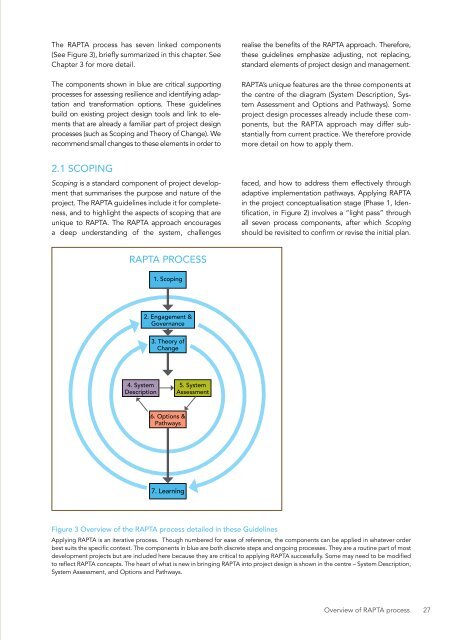DESIGNING PROJECTS IN A RAPIDLY CHANGING WORLD
srun3013fp1
srun3013fp1
You also want an ePaper? Increase the reach of your titles
YUMPU automatically turns print PDFs into web optimized ePapers that Google loves.
The RAPTA process has seven linked components<br />
(See Figure 3), briefly summarized in this chapter. See<br />
Chapter 3 for more detail.<br />
The components shown in blue are critical supporting<br />
processes for assessing resilience and identifying adaptation<br />
and transformation options. These guidelines<br />
build on existing project design tools and link to elements<br />
that are already a familiar part of project design<br />
processes (such as Scoping and Theory of Change). We<br />
recommend small changes to these elements in order to<br />
realise the benefits of the RAPTA approach. Therefore,<br />
these guidelines emphasize adjusting, not replacing,<br />
standard elements of project design and management.<br />
RAPTA’s unique features are the three components at<br />
the centre of the diagram (System Description, System<br />
Assessment and Options and Pathways). Some<br />
project design processes already include these components,<br />
but the RAPTA approach may differ substantially<br />
from current practice. We therefore provide<br />
more detail on how to apply them.<br />
2.1 SCOP<strong>IN</strong>G<br />
Scoping is a standard component of project development<br />
that summarises the purpose and nature of the<br />
project. The RAPTA guidelines include it for completeness,<br />
and to highlight the aspects of scoping that are<br />
unique to RAPTA. The RAPTA approach encourages<br />
a deep understanding of the system, challenges<br />
faced, and how to address them effectively through<br />
adaptive implementation pathways. Applying RAPTA<br />
in the project conceptualisation stage (Phase 1, Identification,<br />
in Figure 2) involves a “light pass” through<br />
all seven process components, after which Scoping<br />
should be revisited to confirm or revise the initial plan.<br />
RAPTA PROCESS<br />
1. Scoping<br />
2. Engagement &<br />
Governance<br />
3. Theory of<br />
Change<br />
4. System<br />
Description<br />
5. System<br />
Assessment<br />
6. Options &<br />
Pathways<br />
7. Learning<br />
Figure 3 Overview of the RAPTA process detailed in these Guidelines<br />
Applying RAPTA is an iterative process. Though numbered for ease of reference, the components can be applied in whatever order<br />
best suits the specific context. The components in blue are both discrete steps and ongoing processes. They are a routine part of most<br />
development projects but are included here because they are critical to applying RAPTA successfully. Some may need to be modified<br />
to reflect RAPTA concepts. The heart of what is new in bringing RAPTA into project design is shown in the centre – System Description,<br />
System Assessment, and Options and Pathways.<br />
Overview of RAPTA process 27


